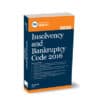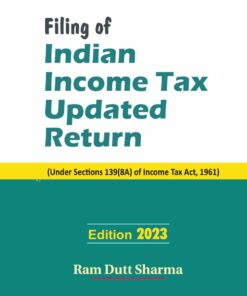- Binding : Hardbound
- Publisher : Taxmann
- Author : Vikash Goel
- Edition : 1st Edition 2025
- Language : English
- ISBN-10 : 9789364555487
- ISBN-13 : 9789364555487
Taxmann’s Valuation of Business Securities & Financial Assets By Vikash Goel – 1st Edition 2025
₹2,295.00 Original price was: ₹2,295.00.₹1,721.00Current price is: ₹1,721.00.
Taxmann’s Valuation of Business Securities & Financial Assets By Vikash Goel – 1st Edition 2025. This book is a comprehensive, practice-oriented guide to valuation in today’s complex economic landscape. It moves seamlessly from foundational concepts—distinguishing price from value—to advanced methods for strategic planning, compliance, litigation, and M&A scenarios. The book integrates theoretical principles with case studies, providing industry insights, analytical tools, and a global perspective enriched by in-depth coverage of Indian regulations. It equips readers with the contextual understanding and strategic acumen vital for informed, effective decision-making by covering specialised topics such as intangibles, distressed firms, and startups.
10 in stock
Taxmann’s Valuation of Business Securities & Financial Assets By Vikash Goel – 1st Edition 2025.
Taxmann’s Valuation of Business Securities & Financial Assets By Vikash Goel – 1st Edition 2025.
Description :-
This book is a comprehensive resource that simplifies the complex world of valuation. As businesses become more globalised and intricate, determining the worth of companies, securities, and various financial assets is no longer solely the purview of niche professionals. This book recognises valuation as a ‘sunrise profession’ in rapidly expanding markets—particularly in India—and acknowledges the growing interest from diverse stakeholders.
It is authored by an experienced practitioner who has valued hundreds of organisations. It offers a well-rounded understanding of traditional valuation concepts and contemporary frameworks influenced by evolving regulations and emerging market trends. The reader learns how to calculate value and why value manifests as it does, considering market conditions, competitive landscapes, innovation, regulation, and more.
This book is an essential reference for professionals, corporate leaders, investors, and students, equipping them with foundational knowledge and advanced strategic acumen.
The Present Publication is 1st Edition authored by Vikash Goel, with the following noteworthy features:
- [Holistic Perspective] The book integrates theoretical rigour with practical insights, marrying quantitative analysis with an understanding of business strategy, industry structure, and macroeconomic trends
- [Global Concepts with Local Focus] While the principles can be applied globally, the author pays special attention to the Indian context—covering the Companies Act, SEBI regulations, and Income Tax provisions—making it invaluable for those navigating the Indian regulatory landscape
- [Illustrations and Case Studies] Readers benefit from numerous examples, case studies, and industry overviews that go beyond formulaic approaches, ensuring they can apply concepts in a variety of real-world settings
- [Comprehensive Coverage of Valuation Methods] From standard discounted cash flow (DCF) and dividend discount models (DDM) to the market and cost approaches, as well as specialised valuation scenarios (intangibles, distressed companies, startups, and complex securities), the book ensures breadth and depth
The structure of the book is as follows:
- The book is structured to guide the reader logically from fundamental valuation principles through increasingly complex topics
- Early chapters focus on foundational concepts—differentiating price and value, analysing various standards of value, and examining the business environment
- Subsequent sections build on this groundwork, discussing corporate finance principles, the interpretation of financial statements, forecasting growth, and calculating the cost of capital
- The latter part of the book addresses specialised areas, such as the valuation of intangible assets, startups, distressed firms, and complex financial instruments, culminating in chapters on mergers, acquisitions, and the regulatory frameworks that shape today’s valuation landscape
The contents of the book are as follows:
- Introducing Valuation
- Understanding the difference between price and value
- Exploring different bases of value (intrinsic, fair, market, liquidation, synergistic, and participant-specific)
- Common purposes of valuation and debunking popular myths
- Identifying and leveraging information sources (management, internet, annual reports)
- Analysing Business Landscape
- Economic, industry, and company analysis tools, including PESTEL, Porter’s Five Forces, SWOT, and more
- Industry overviews covering aviation, FMCG, oil & gas, IT/ITES, healthcare, e-commerce, hospitality, telecom, pharmaceuticals, retail, media, iron & steel
- Case studies (Zara, Indigo Airlines, Blockbuster) to connect theory with practical outcomes
- Corporate Finance
- Fundamentals of risk and return, diversification, and measures like variance, standard deviation, and beta
- Capital budgeting techniques (NPV, IRR) and their impact on valuation
- Dividend policy theories (Walter’s, Gordon’s, Modigliani and Miller’s) and their implications on value
- Valuation Standards
- Introduction to International Valuation Standards (IVS) and a structured valuation framework
- Approaches under IVS (market, income, cost) and their applicability
- Valuation processes, key concepts, and quality control measures
- Analysing Financial Statements
- Analysis of profit & loss statements, balance sheets, and cash flow statements
- Adjusting financial statements for valuation, forecasting future statements, and understanding economic value added (EVA), free cash flows, and the role of ESG considerations
- Cost of Capital
- Determining the appropriate discount rate and its components (cost of equity, cost of debt, WACC)
- Capital structure theories (Net Income, Net Operating Income, MM Hypothesis)
- Challenges in estimating the cost of capital and addressing international considerations
- Estimating Growth Rates
- Examining how ROIC, cost of capital, and sustainable growth rates interact
- Forecasting revenue, costs, margins, taxes, and working capital for accurate growth estimates
- Dividend Discount Model (DDM)
- Zero-growth, constant-growth (Gordon model), two-stage, and three-stage DDM
- Application of DDM in the Indian market context
- Discounted Cash Flow (DCF) Methods Using Free Cash Flows
- When to apply DCF and the steps for FCFF and FCFE calculations
- Adjusting cash flows for taxes, non-operating assets, and sunk costs
- Incorporating ESG factors and determining terminal values
- Market Approach to Valuation
- Understanding market approach methods (market price, comparable companies, comparable transactions)
- Common valuation multiples (P/E, PEG, P/S, P/BV, EV/EBITDA) and industry-specific benchmarks
- Applying discounts for lack of liquidity, marketability, and control
- Cost Approach – Valuation from the Balance Sheet
- Net Asset Value (NAV) and its implications
- References to Rule 11UA under the Indian Income-tax Act
- Illustrative case studies and examples
- Valuation of Private Firms & Startups
- Unique challenges and methods (market, income, cost) for private companies
- Startup life cycles, estimating revenues and TAM, key costs, and customer lifetime value
- Valuation methods like the Venture Capital, Berkus, and cost-to-duplicate approaches
- Valuing Distressed Companies
- Structural factors and distress prediction models (Altman Z-score)
- Case studies illustrating how to value companies in financial trouble
- Valuing Cyclical Businesses
- Challenges in valuing firms prone to economic and industry cycles
- Adjusting growth rates and understanding cyclicality’s impact on value
- Valuing Fixed Income Securities
- Bond valuation, yield measures (YTM, YTC), duration analysis, and factors affecting bond prices
- Valuation of convertible bonds, preference shares, and relevant regulatory guidelines (FIMMDA)
- Valuation of Intangibles
- Identifying common intangible assets and their importance
- Approaches under Ind AS 38 and IVS for valuing intangibles (market, income, cost)
- Determining economic useful life and discount rates
- Valuing Complex Securities
- Introduction to derivatives, options, and advanced financial instruments
- Valuation of ESOPs, real options, and convertible securities
- Case studies on convertible bonds and preference shares
- Valuation Under Mergers & Acquisitions (M&A)
- Understanding synergy, premium, and value creation in M&A deals
- Leveraged Buyouts (LBOs), deal structuring and assessing acquisition feasibility
- Purchase price allocation, anti-takeover defences, and regulatory considerations
- Regulatory Framework Around Valuation
- Key provisions under the Companies Act, Income Tax Act, and IBBI regulations in India
- SEBI regulations, including ICDR, Buy-Back, LODR, NCS, Takeover, and Delisting framework
- Aligning valuations with financial reporting standards (Ind AS 113, Ind AS 103, Ind AS 36, Ind AS 109, Ind AS 40)
Details
| Language | |
|---|---|
| Publisher | |
| Author |
Be the first to review “Taxmann’s Valuation of Business Securities & Financial Assets By Vikash Goel – 1st Edition 2025” Cancel reply
Related products
MSME
Bloomsbury’s Treatise on Micro, Small and Medium Enterprises by Rajeev Babel – 1st Edition June 2021
Direct Tax
Commercial’s Direct Taxes Law & Practice (Professional) By Dr Girish Ahuja & Dr Ravi Gupta
Income Tax
Commercial’s Filing of Indian Income Tax Updated Return by Ram Dutt Sharma – Edition 2023













Reviews
There are no reviews yet.